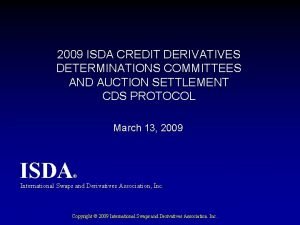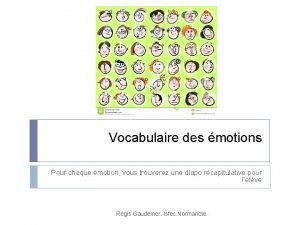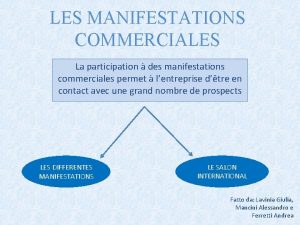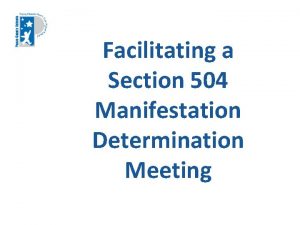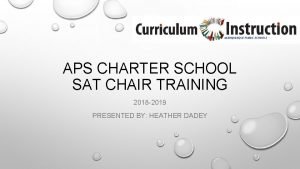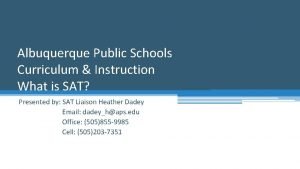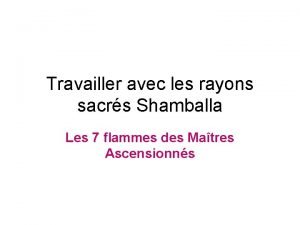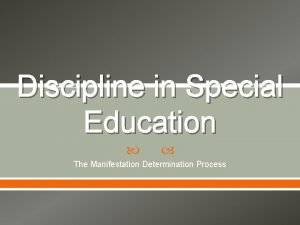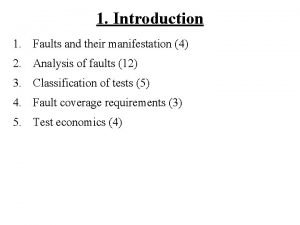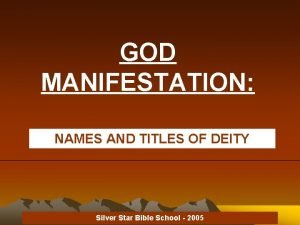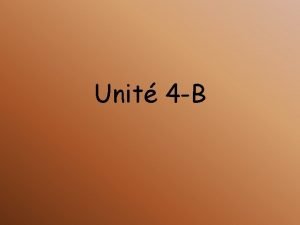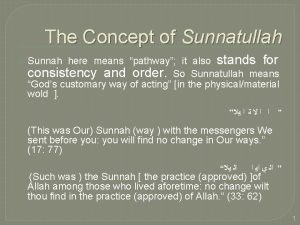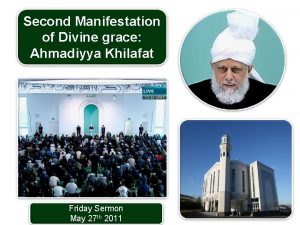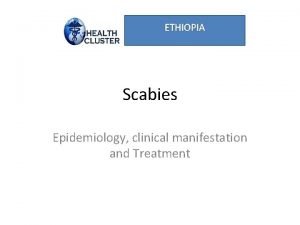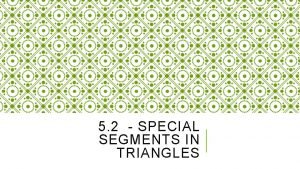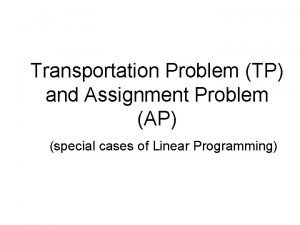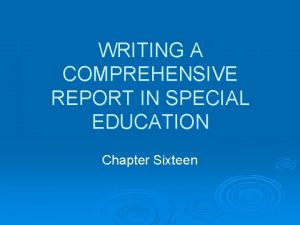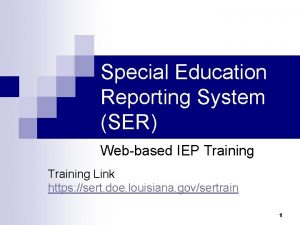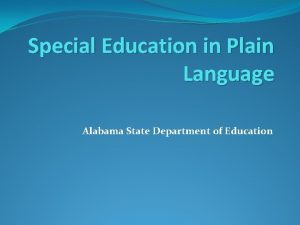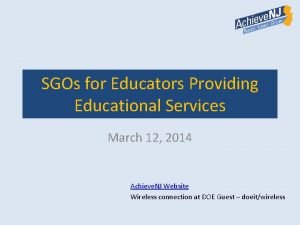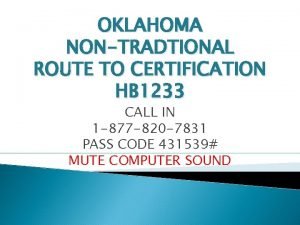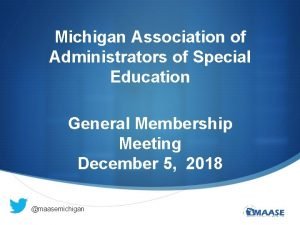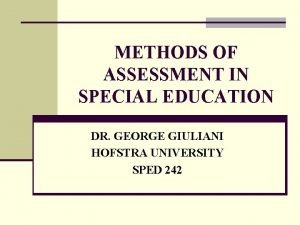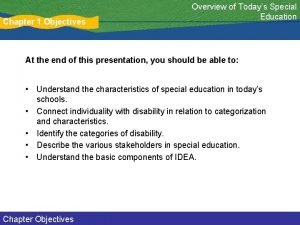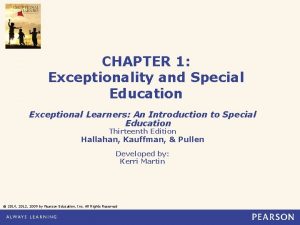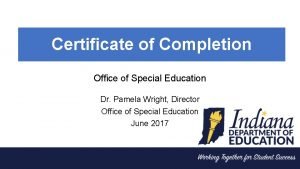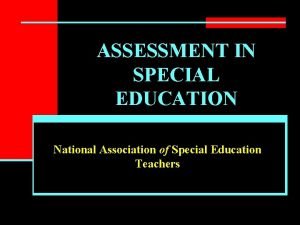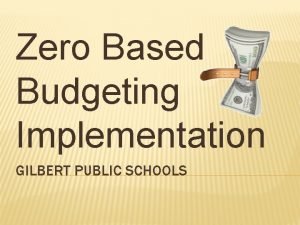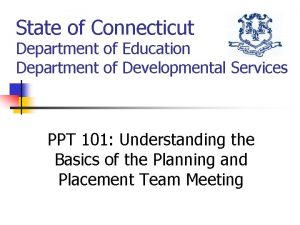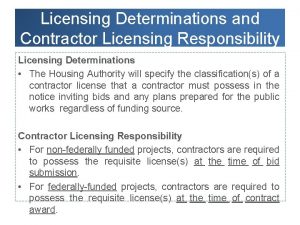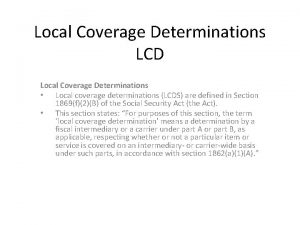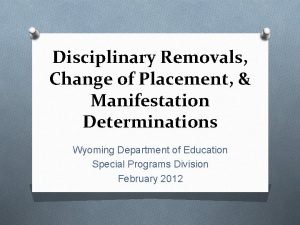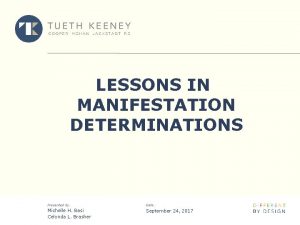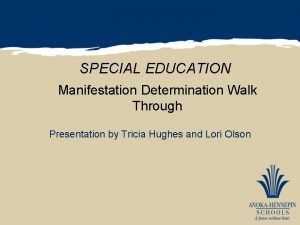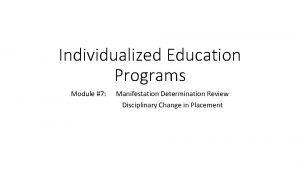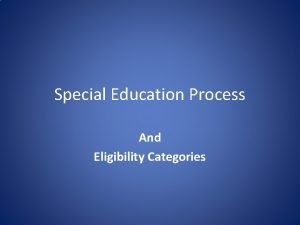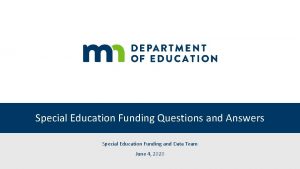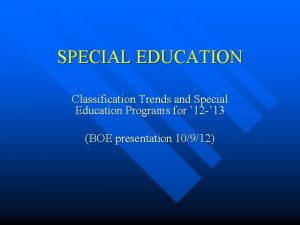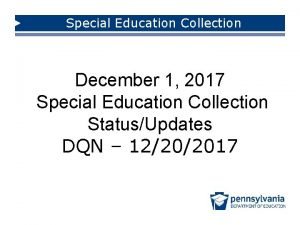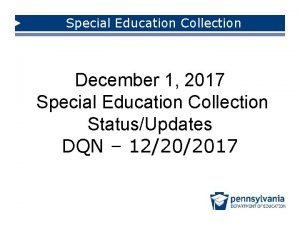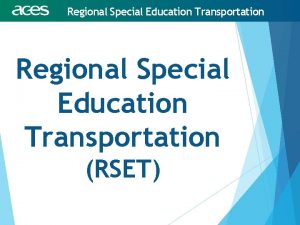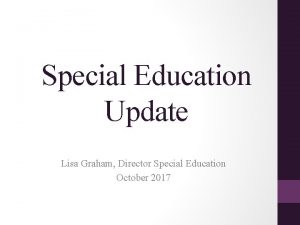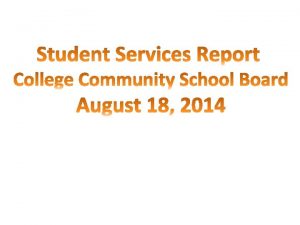Special Education Manifestation Determinations FIRAC Case Review and

















































- Slides: 49

Special Education: Manifestation Determinations

FIRAC Case Review and Class Discussion • Timothy O. • Manifestation Determinations • William Hart 2

Overview of Special Education Discipline

Agenda Overview of Special Education Discipline Students NOT Eligible Basis of Knowledge Students Eligible for Special Education Manifestation Determinations 4

Overview of Special Education Discipline In 1970, U. S. schools educated only one in five children with disabilities and many states had laws excluding certain disabled students from school. In 1975, Congress passed Public Law 94 -142, which guaranteed a free appropriate public education to each child with a disability. (U. S. Dpt. Of Ed. “IDEA: Thirty-Five Years of Progress in Educating Children With Disabilities Through IDEA, Washington D. C. , 201. ) 5

Overview of Special Education Discipline Students with disabilities served by IDEA are more than twice as likely to receive one or more out-of-school suspensions as students without disabilities. Students with disabilities served by IDEA represent 12% of all students, but 67% of students subject to restraint or seclusion. U. S. Dept. of Education “ 2013 -14 Civil Rights Data Collection, ” Washington D. C. , 2016 6

Overview of Special Education Discipline Under federal and state special education law, students with disabilities are afforded certain rights in disciplinary matters.

Overview of Special Education Discipline Students Entitled to Discipline Protections Special education students (identified with a disability under IDEA) Students not identified as having a disability under Students with IDEA or disabilities Section 504 for under Section whom District 504 had “basis of knowledge”

Overview of Special Education Discipline Protections Afforded to Students with Disabilities • Individuals with Disabilities in Education Act (“IDEA”) • Section 504 of the Rehabilitation Act of 1973 (“Section 504”) • Americans with Disabilities Act (“ADA”)

Overview of Special Education Discipline Enforcement • Office of Administrative Hearings (“OAH”) • California Department of Education (“CDE”) • U. S. Department of Education/Office for Civil Rights (“OCR”) • State and Federal Courts

Overview of Special Education Discipline Days of Suspension 1 2 3 4 Can discipline with suspension for up to 10 days 5 6 7 8 9 10 11 For the 11 th day (and each day of suspension thereafter), must hold manifestation determination

Overview of Special Education Discipline Special education student discipline protections apply whenever: (1) The District seeks to make a disciplinary change in a special education student’s placement; or (2) The District had “knowledge” that the student was a child with a disability.

Students NOT Eligible for Special Education: “Basis of Knowledge”

Hypothetical • 14 -year-old male in 9 th grade, 3. 88 GPA • Honors and advanced courses • Described as “active, ” “viable, ” “passionate” about his ideas, “goes above and beyond” • Never been assessed or referred for special education • Suspended, pending expulsion, for admitted sexual harassment and sexual battery of a female student • Notice of ASD? 14

Basis of Knowledge A child who has not been determined to be eligible for special education … …who has engaged in behavior that violated a code of student conduct, may assert any of the protections provided for in this part if the public agency had knowledge […] that the child was a child with a disability before the behavior that precipitated the disciplinary action that occurred. ” (34 C. F. R. § 300. 534(a). )

Basis of Knowledge: Who Is Covered? Student who -- 1. Has not yet been identified as eligible for special education, 2. But the district had a basis of knowledge of the student’s disability prior to the occurrence of the behavior that precipitated the disciplinary action.

How Is “Basis of Knowledge” Established?

When Does a District Have a Basis of Knowledge? District will be deemed to have had knowledge of a student’s disability if: 1. Parent expressed concern in writing that the student is in need of special education and related services; 2. Parent requested special education assessment; or 3. Personnel expressed specific concerns about a pattern of behavior. (34 C. F. R. § 300. 534(b). )

EXCEPTIONS: NO Basis of Knowledge District will NOT be deemed to have had knowledge of a student’s disability if: 1. Parent refused to permit the District to conduct an evaluation; 2. Parent refused special education services; or 3. District conducted evaluation and determined the student was not eligible. (34 C. F. R. § 300. 534(c). )

What Happens When a District is Deemed to Have Basis of Knowledge?

What Happens? NO Basis of Knowledge • No IDEA protections are available – proceed with discipline • Parents may request an evaluation Basis of Knowledge • Conduct a manifestation determination if there will be a disciplinary change in placement • Stay put

Return to Hypothetical • Option 1: If no basis of knowledge, refuse to hold MD • Option 2: – Hold MD and offer to assess in an expedited manner. – Hold IEP meeting to discuss eligibility. – If eligible for special education, hold another MD within the timeline. If not eligible, no need to hold another MD. 22

Students Eligible for Special Education

Change of Placement A change of placement occurs if: Removal for more than 10 consecutive school days, or More than 10 cumulative days of short-term removals and constitute a pattern 24

Change of Placement • Removals constitute a pattern when: – Removals total more than 10 school days in a school year; – Behavior is substantially similar to the child’s behavior in previous incidents that resulted in the series of removals; and – Additional factors such as the length of time of the removal, the total amount of time of the removal, and the proximity of the removals to each other. 25

Change of Placement: Interim Alternative Educational Settings • A student may be moved to an IAES for up to 45 school days if the student does any of the following at school or at a school function: – Possesses a weapon; – Possesses or uses illegal drugs, or sells or solicits the sale of a controlled substance; or – Has inflicted serious bodily injury upon another person while at school, on school grounds or at a school function. 26

Change of Placement: Grounds for IAES • Special Circumstances IAES Expedited Due Process Hearing • 45 school day maximum. • Regardless of results of MD. • If district believes maintaining current placement is substantially likely to result in injury = initiate due process hearing • Only if student: – Carries/possesses weapon; – Knowingly possess, uses, sells or solicits sale of illegal drugs or controlled substance; – Inflicts serious bodily injury upon another person. • Expedited due process hearing. • ALJ can place student in IAES; district may repeat the process at the expiration of 45 days. 27

Change of Placement Regardless of how serious the conduct is, and whether it constitutes a special circumstance, school district must still conduct a manifestation determination after the removal. 28

Change of Placement In-School Suspensions 29

Change of Placement: In-School Suspension NOT a Removal if student given opportunity to: 1. Participate in the general ed. curriculum 2. Receive the services specified in IEP 3. Participate with nondisabled children to the same extent 30

Change of Placement Suspensions for less than one full school day 31

Change of Placement Bus Suspensions 32

MANIFESTATION DETERMINATIONS

Manifestation Determinations A manifestation determination (“MD”) is an evaluation of a child’s misconduct to determine whether the conduct was a manifestation of the child’s disability. 34

Manifestation Determinations • A manifestation determination must be held when a district proposes disciplinary measures that will result in a change of placement for a child with a disability. • The MD analysis must be performed within 10 school days of “any decision to change the placement of a child with a disability because of a violation of a code of student conduct. ” 34 CFR § 300. 530 (e). 35

Manifestation Determinations • The MD Review must include at least one parent/guardian and relevant members of the student’s IEP team. – It is best to have the whole IEP team present. • Review all relevant information in the student’s file, including the IEP, teacher observations, and any other relevant information provided by the parents. 34 CFR § 300. 530 (e). 36

Manifestation Determinations The IEP team will determine whether the student’s behavior that led to the discipline was Caused by, or had a direct and substantial relationship to, the child’s disability; or The direct result of the district’s failure to implement the student’s IEP. 37

Manifestation Determinations • If the answer to both questions is “no”: – The District can discipline the student in the same manner as general education students. – The District may need to conduct behavioral assessment or offer behavioral interventions. – Student must continue to receive educational services so as to enable the child to continue to participate in the general ed curriculum and to progress toward meeting IEP goals 34 CFR § 300. 530(d) 38

Manifestation Determinations • If the answer to either question is “yes”: – Student cannot be further disciplined. – Return the student to the placement from which they were removed, unless placement is changed through IEP process or student is placed in IAES. – Must conduct behavioral assessment and develop behavioral intervention plan • unless the student already has one, in which case must review and modify as necessary. – If IEP was not properly implemented, must take immediate steps to remedy this. 39

Manifestation Determinations • At each subsequent suspension past 10 days, the team MUST conduct a MD, even for the same offense. • A school site may NOT exceed 20 days of suspension for a special education student. 40

Manifestation Determinations Question: What if parents disagree with decision? 41

Manifestation Determinations Answer: Parents have a right to file for due process. 42

Manifestation Determinations Stay Put During the pendency of any dispute(s), a special education student is entitled to remain in his or her current educational placement, unless the parties agree otherwise. 34 C. F. R. § 300. 518 subd. (a) 43

Manifestation Determinations Honig v. Doe • Honig is the touchstone Supreme Court case regarding the IDEA’s “stay put” provisions. • Judicial relief to remove “dangerous” student from school is an exception to stay put. 44

Section 504 Discipline • MD meeting must be held to determine if the student’s behavior was a manifestation of their documented disability. • A 504 student is not entitled to services on Day 11 of suspension. 45

Questions 46

PLEASE NOTE These materials are for instructional purposes only. This information is not intended as legal advice. If you need a legal opinion on this subject matter, contact Lozano Smith at www. lozanosmith. com. 47

Additional Note All rights reserved. No portion of this work may be copied, or sold or used for any commercial advantage or private gain, nor any derivative work prepared therefrom, without the express prior written permission of Lozano Smith through its Managing Shareholder. The Managing Shareholder of Lozano Smith hereby grants permission to any client of Lozano Smith to whom Lozano Smith provides a copy to use such copy intact and solely for the internal educational purposes of such client. 48

Disclaimer: These materials and all discussions of these materials are for instructional purposes only and do not constitute legal advice. If you need legal advice, you should contact your local counsel or an attorney at Lozano Smith. If you are interested in having other in-service programs presented, please contact clientservices@lozanosmith. com or call (559) 431 -5600. Copyright © 2016 Lozano Smith All rights reserved. No portion of this work may be copied, or sold or used for any commercial advantage or private gain, nor any derivative work prepared there from, without the express prior written permission of Lozano Smith through its Managing Partner. The Managing Partner of Lozano Smith hereby grants permission to any client of Lozano Smith to whom Lozano Smith provides a copy to use such copy intact and solely for the internal purposes of such client. 488849 49
 Commodity jurisdiction final determinations
Commodity jurisdiction final determinations Isda determinations committee
Isda determinations committee Best case worst case average case
Best case worst case average case Vocabulaire de l'étonnement
Vocabulaire de l'étonnement Manifestation commerciale exemple
Manifestation commerciale exemple Manifestation determination meeting agenda
Manifestation determination meeting agenda Canvas.aps
Canvas.aps Manifestation determination flowchart
Manifestation determination flowchart Manifestation shamballa
Manifestation shamballa The manifestation of the holy spirit
The manifestation of the holy spirit Les 6 dimensions de l'homme selon virginia henderson
Les 6 dimensions de l'homme selon virginia henderson Manifestation determination process
Manifestation determination process Fault is manifestation of defects.
Fault is manifestation of defects. Manifestation names
Manifestation names Clinical manifestation of hepatitis
Clinical manifestation of hepatitis Manifestation of god name
Manifestation of god name Hemorrhagic
Hemorrhagic Vocabulaire manifestation
Vocabulaire manifestation Meaning of sunnatullah
Meaning of sunnatullah Friday manifestation
Friday manifestation Bbl lotion for scabies
Bbl lotion for scabies Special segments in triangles
Special segments in triangles Factoring flow chart
Factoring flow chart An ap is a special case of tp, when
An ap is a special case of tp, when Stoke's theorem gives the relation between
Stoke's theorem gives the relation between Which of these are valued as a special zero-growth case
Which of these are valued as a special zero-growth case Long case and short case
Long case and short case Binary search big o
Binary search big o Bubble sort best case and worst case
Bubble sort best case and worst case Bubble sort best case and worst case
Bubble sort best case and worst case Bubble sort best case and worst case
Bubble sort best case and worst case Ambiguous case triangle example
Ambiguous case triangle example How to write a comprehensive report
How to write a comprehensive report Louisiana special education reporting system
Louisiana special education reporting system Special education in plain language
Special education in plain language Special education academy
Special education academy Universal design for learning definition
Universal design for learning definition Sgo examples for special education
Sgo examples for special education Oklahoma special education boot camp
Oklahoma special education boot camp National council for special education
National council for special education Michigan association of school administrators
Michigan association of school administrators Assessment process in special education
Assessment process in special education Oklahoma special education handbook
Oklahoma special education handbook Objectives of special education
Objectives of special education Exceptional learners: an introduction to special education
Exceptional learners: an introduction to special education Certificate of completion special education
Certificate of completion special education Special education free apps
Special education free apps Nrt and crt examples
Nrt and crt examples Gilbert public schools special education
Gilbert public schools special education Iep components special education
Iep components special education

